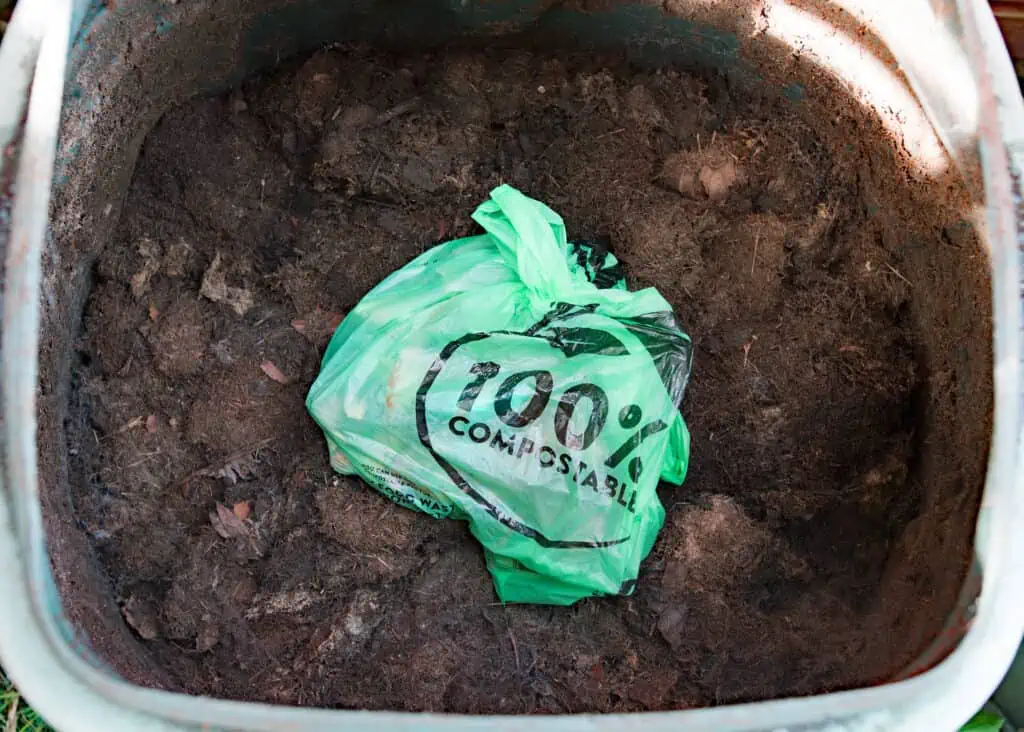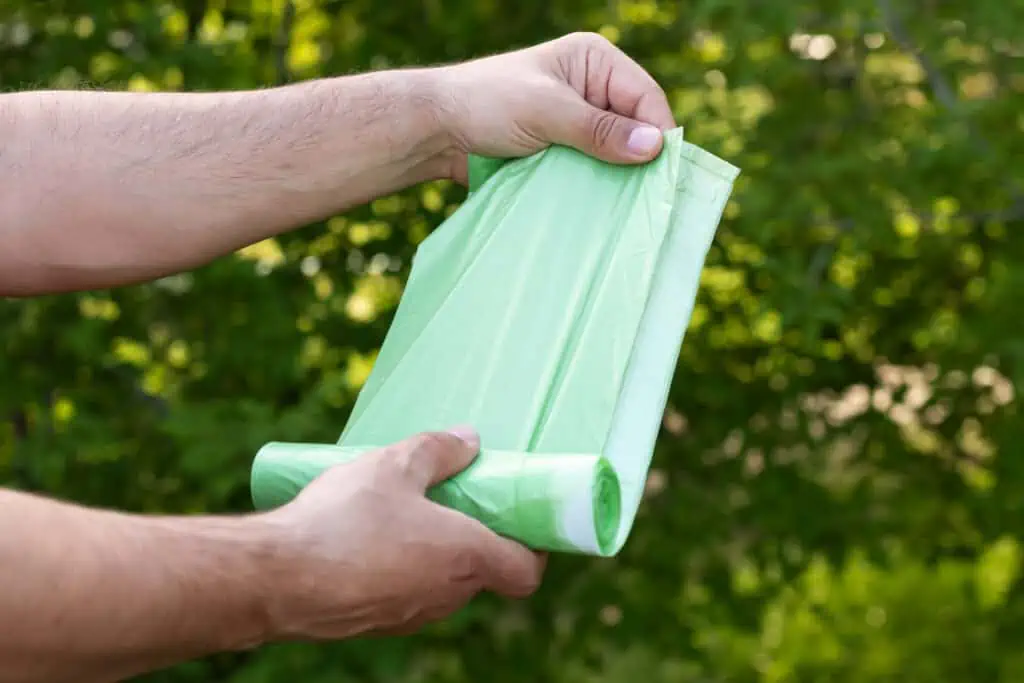As an Amazon Associate I earn from qualifying purchases.
At A Glance
Compostable bags are designed to break down in composting conditions into water, carbon dioxide, and biomass, leaving no toxic residue. However, their compostability can vary based on the conditions they are subjected to. In industrial composting facilities, which have controlled high-temperature conditions, these bags can break down efficiently within a few months. On the other hand, in home composting setups, compostable bags may take longer to decompose due to lower temperatures and varying conditions. Some may not break down completely in home compost bins at all.
Compostable bags have become increasingly popular in recent years as people look for ways to reduce their environmental footprint. These bags are marketed as a sustainable alternative to traditional plastic bags, but are they really compostable? In this article, I will explore the question of whether compostable bags actually break down as intended and provide some insight into the composting process.

Compostable bags are made from plant-based materials and are designed to break down in a composting environment. However, not all compostable bags are created equal. Some are only compostable in industrial facilities, while others can break down in home composting systems. It’s important to read the labels carefully and understand the composting requirements for each type of bag.
Composting is a natural process that involves the breakdown of organic matter into nutrient-rich soil. When done correctly, composting can divert food waste from landfills and reduce greenhouse gas emissions. However, not all materials are suitable for composting. In the next section, I will discuss the requirements for successful composting and how compostable bags fit into the process.
Understanding Compostability
Compostable bags are designed to break down into natural components that can be safely returned to the earth. The composting process relies on microorganisms that break down organic matter into a nutrient-rich soil amendment.
When it comes to compostable bags, there are a few key factors that determine whether or not they are truly compostable. These include the materials used to make the bag, the conditions under which it will decompose, and the specific composting system in which it will be used.
Composting is a natural process that relies on microorganisms to break down organic waste. These microbes require specific conditions in order to thrive, including the right balance of carbon and nitrogen, moisture, and oxygen.
Compostable bags are designed to decompose under specific conditions, which may vary depending on the composting system being used. Some compostable bags are designed for home composting, while others are designed for industrial or municipal composting systems.
In general, compostable bags are made from natural materials such as plant starches, which can be broken down by microorganisms in the compost pile. However, it is important to note that not all compostable bags are created equal. Some may break down more quickly than others, while others may require specific conditions in order to decompose properly.
If you are considering using compostable bags, it is important to choose a product that is certified as compostable by a reputable organization such as the Biodegradable Products Institute (BPI). This certification ensures that the bag will break down properly under specific conditions, and will not leave behind harmful residues in the compost.
Overall, compostable bags can be a great option for those looking to reduce their environmental impact. However, it is important to choose a product that is truly compostable and to use it in the appropriate composting system in order to ensure that it breaks down properly.
Compostable Bags: What Are They?

Compostable bags are a type of bag that is designed to break down into compost when it is disposed of properly. These bags are made from natural plant starches, which means that they do not produce any toxic materials. During composting, compostable bags decompose readily due to microbial activity.
It is important to note that compostable bags are different from biodegradable bags. Biodegradable bags are made from plastic that breaks down into smaller pieces over time. However, these smaller pieces can still be harmful to the environment and take a long time to break down completely.
Compostable bags, on the other hand, are made from materials that allow microbial organisms to eat them. These materials include plants, vegetable oils, and a compostable resin sourced in Italy called Mater-Bi, the world’s first bio-polymer made from cornstarch.
It is also important to note that not all compostable bags are created equal. Some bags are only commercially compostable, which means that they require specific conditions to break down properly. It is important to bring these bags to be composted somewhere that offers industrial composting, such as your municipality’s compost dropoff bins. Just make sure to ask if these bags are accepted.
Certified compostable bags are a better option since they have been tested and certified to break down properly in a composting environment. These bags meet specific standards set by organizations like the Biodegradable Products Institute (BPI) and the European Bioplastics Association (EUBP).
In summary, compostable bags are a sustainable option for those looking to reduce their environmental impact. They are made from natural plant starches, which means they do not produce any toxic materials and break down readily during composting due to microbial activity. However, it is important to ensure that you are using certified compostable bags to ensure that they break down properly.
Composting Process and Factors

Composting is a natural process that breaks down organic matter into nutrient-rich soil. It involves microbial activity, temperature, and moisture levels, among other factors. The process can take anywhere from a few weeks to several months, depending on the conditions.
One of the key factors in composting is temperature. The ideal temperature range for composting is between 120 and 160 degrees Fahrenheit (49 and 71 degrees Celsius). This temperature range helps to kill pathogens and weed seeds and accelerates the breakdown of organic matter.
Microbial activity is also an important factor in composting. Microbes, such as bacteria and fungi, break down the organic matter into smaller particles. They also produce heat as a byproduct of their metabolic processes, which helps to maintain the ideal temperature range for composting.
Food scraps and yard trimmings are common sources of organic matter for composting. Food scraps, such as fruit and vegetable peels, eggshells, and coffee grounds, are high in nitrogen. Yard trimmings, such as grass clippings and leaves, are high in carbon. A balance of nitrogen and carbon is important for successful composting.
Moisture levels are also critical for composting. The compost pile should be moist, but not too wet or too dry. A moisture level of around 50% is ideal. Too much moisture can cause the compost to become anaerobic, which slows down the composting process and can produce unpleasant odors.
In summary, composting is a natural process that involves temperature, microbial activity, moisture levels, and the right balance of organic matter. By understanding these factors and providing the right conditions, compostable bags can be successfully composted.
Regulations and Standards
As consumers become more environmentally conscious, there has been an increase in the demand for compostable bags. However, with the rise of greenwashing, it is essential to understand the regulations and standards regarding compostable bags.
The Environmental Protection Agency (EPA) has established guidelines for compostable products. According to the EPA, compostable products must meet ASTM D6400 or D6868 standards. ASTM D6400 is the standard specification for compostable plastics, while D6868 is the standard test method for determining aerobic biodegradation of plastic materials in soil. These standards ensure that compostable products will break down into carbon dioxide, water, and organic matter within a specified time frame.
The Biodegradable Products Institute (BPI) is a third-party certification organization that verifies compostable products’ compliance with ASTM standards. BPI certification ensures that the product will break down in an industrial composting facility within 180 days. BPI-certified products must also meet the Federal Trade Commission’s (FTC) Green Guides, which prohibit deceptive environmental claims.
It is important to note that not all compostable bags are created equal. Some bags may claim to be compostable but do not meet the necessary standards. Therefore, it is crucial to look for BPI certification and ASTM standards compliance when purchasing compostable bags.
In conclusion, compostable bags must meet specific standards to ensure that they break down into organic matter within a specified time frame. The EPA, BPI, ASTM, and FTC have established guidelines and certifications to ensure that compostable products are legitimate and environmentally friendly.
Compostable vs Biodegradable vs Recyclable
When it comes to sustainable packaging, there are three terms that are often used interchangeably: compostable, biodegradable, and recyclable. While they may seem similar, there are important differences between them that can affect their environmental impact.
Recyclable items can be turned into raw materials that can then be used to make new things without needing to create completely new resources. However, not all plastics are recyclable, and even those that are may not be recycled due to contamination or lack of infrastructure.
Biodegradable options will eventually break down, but we don’t know when or how they will break down. Some biodegradable plastics require specific conditions to break down, such as high heat or UV light, which may not be present in a landfill or composting facility. Additionally, some biodegradable plastics are made from petroleum-based materials, which can still harm the environment.
Compostable items, on the other hand, are designed to break down completely and can then be used to grow more resources. Compostable plastics are typically made from plant-based materials, such as cornstarch or sugarcane, and require specific conditions to break down, such as heat and moisture. However, not all compostable plastics are created equal, and some may not break down as quickly or completely as others.
It’s important to note that even compostable and biodegradable plastics may not be a sustainable solution if they are used for single-use purposes. The production and disposal of any type of plastic can have a negative impact on the environment, and reducing our overall consumption of plastic is crucial for a more sustainable future.
Composting Facilities and Methods
Composting is the process of breaking down organic matter into nutrient-rich soil. It’s a natural process that occurs in nature, but it can also be done at home or in commercial facilities. In order for compostable bags to break down properly, they need to be composted in the right conditions.
Home composting is a popular method for reducing waste and creating nutrient-rich soil. Home composting can be done in a variety of ways, but the most common method is using a compost bin. Compost bins come in different sizes and styles, and they can be made from a variety of materials such as plastic, metal, or wood. When using a compost bin, it’s important to keep the right balance of green and brown materials, such as food scraps, yard waste, and dry leaves.
Commercial composting is another option for composting. Commercial composting facilities are designed to handle large amounts of organic waste, and they use specialized equipment to speed up the composting process. Commercial composting facilities can be found in many communities, and they can accept a wide range of organic materials, including compostable bags.
It’s important to note that not all compostable bags are created equal. Some compostable bags are designed for home composting, while others are only suitable for commercial composting. It’s important to check the packaging to see if the bag is home compostable or commercially compostable.
When composting, it’s important to follow the guidelines set by your local composting facility. Different facilities may have different requirements for what can and cannot be composted. Some facilities may only accept certain types of compostable bags, while others may not accept any at all. It’s important to check with your local facility to see what their requirements are.
In conclusion, composting is a great way to reduce waste and create nutrient-rich soil. Whether you choose to compost at home or in a commercial facility, it’s important to follow the guidelines set by your local composting facility to ensure that your compostable bags break down properly.
Environmental Impact
Compostable bags have been marketed as a more environmentally friendly alternative to traditional plastic bags. However, their impact on the environment is still a matter of debate.
One issue with compostable bags is that they often end up in landfills, where they do not decompose properly. In fact, compostable bags can even have a worse environmental impact than regular plastic bags if they are not disposed of properly. When compostable bags end up in landfills, they contribute to the production of greenhouse gases, such as carbon dioxide and methane, which are harmful to the environment.
Another issue is that compostable bags can break down into microplastics, which can be harmful to marine environments and the natural environment as a whole. While compostable bags may break down more quickly than traditional plastic bags, they can still cause harm to the environment if they are not disposed of properly.
Overall, compostable bags can have a positive impact on the environment if they are disposed of properly. However, it is important to note that compostable bags are not a perfect solution to the plastic pollution problem. It is important to reduce our use of all types of single-use plastics, including compostable bags, and to dispose of them properly to minimize their impact on the environment.
Potential Issues and Controversies
Compostable bags are marketed as an eco-friendly alternative to traditional plastic bags. However, there are several potential issues and controversies surrounding the use of compostable bags.
One issue is contamination. If compostable bags are not properly disposed of, they can contaminate the recycling stream. This can lead to issues with the composting process and can even render the entire batch of compost unusable. It is important to ensure that compostable bags are disposed of properly, and that they are not mixed with other types of waste.
Another issue is the use of PFAS in some compostable bags. PFAS are chemicals that have been linked to a range of health problems, including cancer and developmental issues. While not all compostable bags contain PFAS, it is important to be aware of this potential issue and to choose compostable bags that are free from these chemicals.
There is also controversy surrounding the degradability of compostable bags. While some compostable bags are designed to break down quickly, others may take longer to degrade. It is important to choose compostable bags that are certified by a reputable organization, such as the Biodegradable Products Institute (BPI) or the Compost Manufacturing Alliance (CMA).
Overall, while compostable bags can be a more eco-friendly alternative to traditional plastic bags, it is important to be aware of their potential issues and controversies. By choosing compostable bags that are free from PFAS and certified by a reputable organization, and by ensuring that they are properly disposed of, we can help to minimize the environmental impact of our waste.
Practical Uses of Compostable Bags
As someone who is environmentally conscious, I have found that compostable bags can be a great alternative to traditional plastic bags. Here are some practical uses for compostable bags:
Trash Bags
Compostable bags can be used as trash bags for your home or office. They are just as durable as plastic bags and can hold a significant amount of waste. Once you have filled the bag, you can dispose of it in your compost bin or take it to a commercial composting facility.
Dog Poop Bags
Compostable bags can also be used as dog poop bags. They are a great alternative to plastic bags that can take hundreds of years to decompose. Compostable bags are made from natural plant starch, which means they will break down quickly and won’t harm the environment.
Paper Bags
If you prefer to use paper bags, you can also opt for compostable paper bags. These bags are made from recycled paper and are fully compostable. They are a great alternative to plastic bags and can be used for a variety of purposes, including grocery shopping and carrying items around town.
Eco-Friendly
Compostable bags are an eco-friendly alternative to traditional plastic bags. They are made from renewable resources and break down quickly, which means they won’t harm the environment. Additionally, they can be used for a variety of purposes, making them a versatile option for anyone looking to reduce their environmental impact.
In summary, compostable bags have practical uses, such as being used as trash bags, dog poop bags, and paper bags. They are also eco-friendly and made from renewable resources.
Conclusion
In conclusion, compostable bags are a promising alternative to traditional plastic bags. However, it is important to note that not all compostable bags are created equal. Some compostable bags may not meet the necessary standards for compostability, and may not break down as intended.
Consumers should look for compostable bags that are certified by reputable third-party organizations such as the Biodegradable Products Institute (BPI) in North America. These certifications ensure that the bags meet the necessary standards for compostability and will break down in a composting environment.
It is also important to note that compostable bags should not be mixed with regular plastic bags in recycling or waste streams. This can contaminate the recycling process and prevent the bags from breaking down properly in a composting environment.
Overall, compostable bags have the potential to reduce the environmental impact of traditional plastic bags. However, it is important to use them properly and ensure that they meet the necessary standards for compostability.
